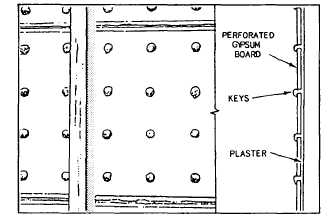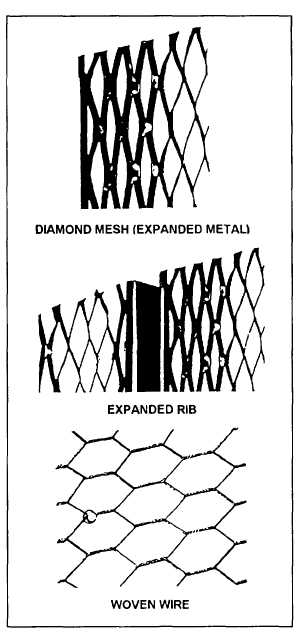Figure 7-3.—Keys formed with perforated gypsum board.
There is also a special fire-retardant gypsum lath,
called type X. It has a specially formulated core,
containing minerals giving it additional fire protection.
Use only one manufacturer’s materials for a
specified job or area. This ensures compatibility. Always
strictly follow the manufacturer’s specifications for
materials and conditions of application.
Plain gypsum lath plaster base is used in several
situations: for applying nails and staples to wood and
nailable steel framing; for attaching clips to wood
framing, steel studs, and suspended metal grillage; and
for attaching screws to metal studs and furring channels.
Common sizes include 16 by 48 inches, 3/8 or 1/2 inch
thick, and 16 by 96 inches, 3/8 inch thick.
Perforated gypsum lath plaster base is the same as
plain gypsum lath except that 3/4-inch round holes are
punched through the lath 4 inches on center (OC) in each
direction. This gives one 3/4-inch hole for each
16 square inches of lath area. This provides mechanical
keys in addition to the natural plaster bond and obtains
higher fire ratings. Figure 7-3 shows back and side
views of a completed application.
Insulating gypsum lath plaster base is the same as
plain gypsum lath, but with bright aluminum foil
laminated to the back. This creates an effective vapor
barrier at no additional labor cost. In addition, it
provides positive insulation when installed with the foil
facing a 3/4-inch minimum air space. When insulating
gypsum lath plaster is used as a ceiling, and under winter
heating conditions, its heat-resistance value is
approximately the same as that for 1/2-inch insulation
board.
Long lengths of gypsum lath are primarily used for
furring the interior side of exterior masonry walls. It is
available in sizes 24 inches wide, 3/8 inch thick, and up
to 12 feet in length.
Figure 7-4.-Types of metal lath.
Gypsum lath is easily cut by scoring one or both
sides with a utility knife. Break the lath along the scored
line. Be sure to make neatly fitted cutouts for utility
openings, such as plumbing pipes and electrical outlets.
Metal Lath
Metal lath is perhaps the most versatile of all plaster
bases. Essentially a metal screen, the bond is created by
keys formed by plaster forced through the openings. As
the plaster hardens, it becomes rigidly interlocked with
the metal lath.
Three types of metal lath are commonly used:
diamond mesh (expanded metal), expanded rib, and
wire mesh (woven wire). These are shown in figure 7-4.
7-5



